Analysis of HR Management, Motivation, and Productivity for BEM
VerifiedAdded on 2023/02/01
|10
|2094
|99
Report
AI Summary
This report examines the critical relationship between human resource management, employee motivation, and productivity, using the BEM vacuum cleaner manufacturer as a case study. The analysis addresses the company's high labor turnover rate, exploring motivational theories such as Maslow's hierarchy and Herzberg's factors. It identifies issues like lack of health and safety policies, long working hours, and constant wages as key contributors to employee dissatisfaction and absenteeism. The discussion evaluates both financial and non-financial incentives, highlighting the significance of hygiene and motivational factors in retaining employees. The report concludes with recommendations, including improvements in working conditions, health and safety measures, and the implementation of motivational strategies such as incentives, rewards, and training programs to reduce labor turnover and enhance overall productivity and profitability.
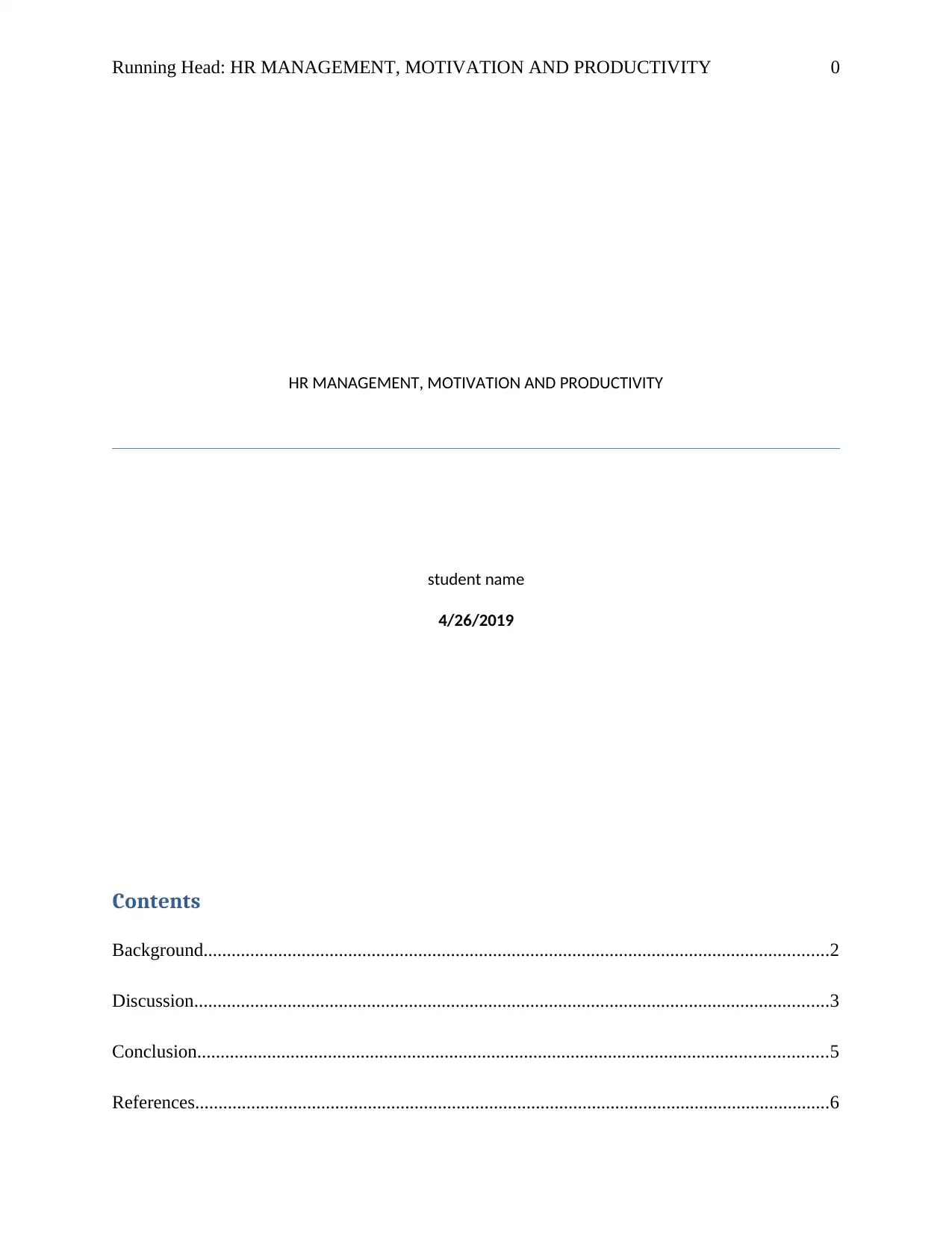
Running Head: HR MANAGEMENT, MOTIVATION AND PRODUCTIVITY 0
HR MANAGEMENT, MOTIVATION AND PRODUCTIVITY
student name
4/26/2019
Contents
Background......................................................................................................................................2
Discussion........................................................................................................................................3
Conclusion.......................................................................................................................................5
References........................................................................................................................................6
HR MANAGEMENT, MOTIVATION AND PRODUCTIVITY
student name
4/26/2019
Contents
Background......................................................................................................................................2
Discussion........................................................................................................................................3
Conclusion.......................................................................................................................................5
References........................................................................................................................................6
Paraphrase This Document
Need a fresh take? Get an instant paraphrase of this document with our AI Paraphraser
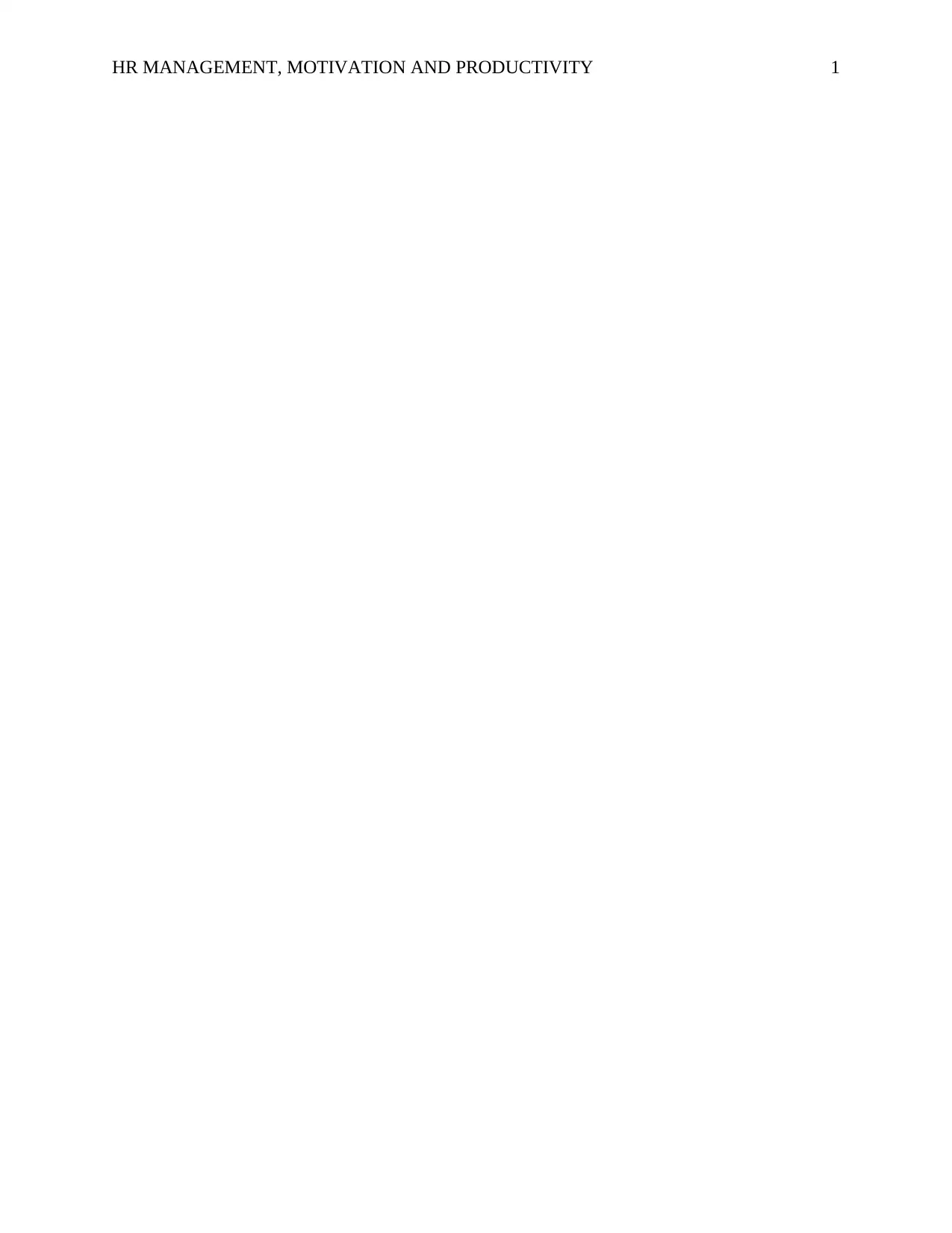
HR MANAGEMENT, MOTIVATION AND PRODUCTIVITY 1
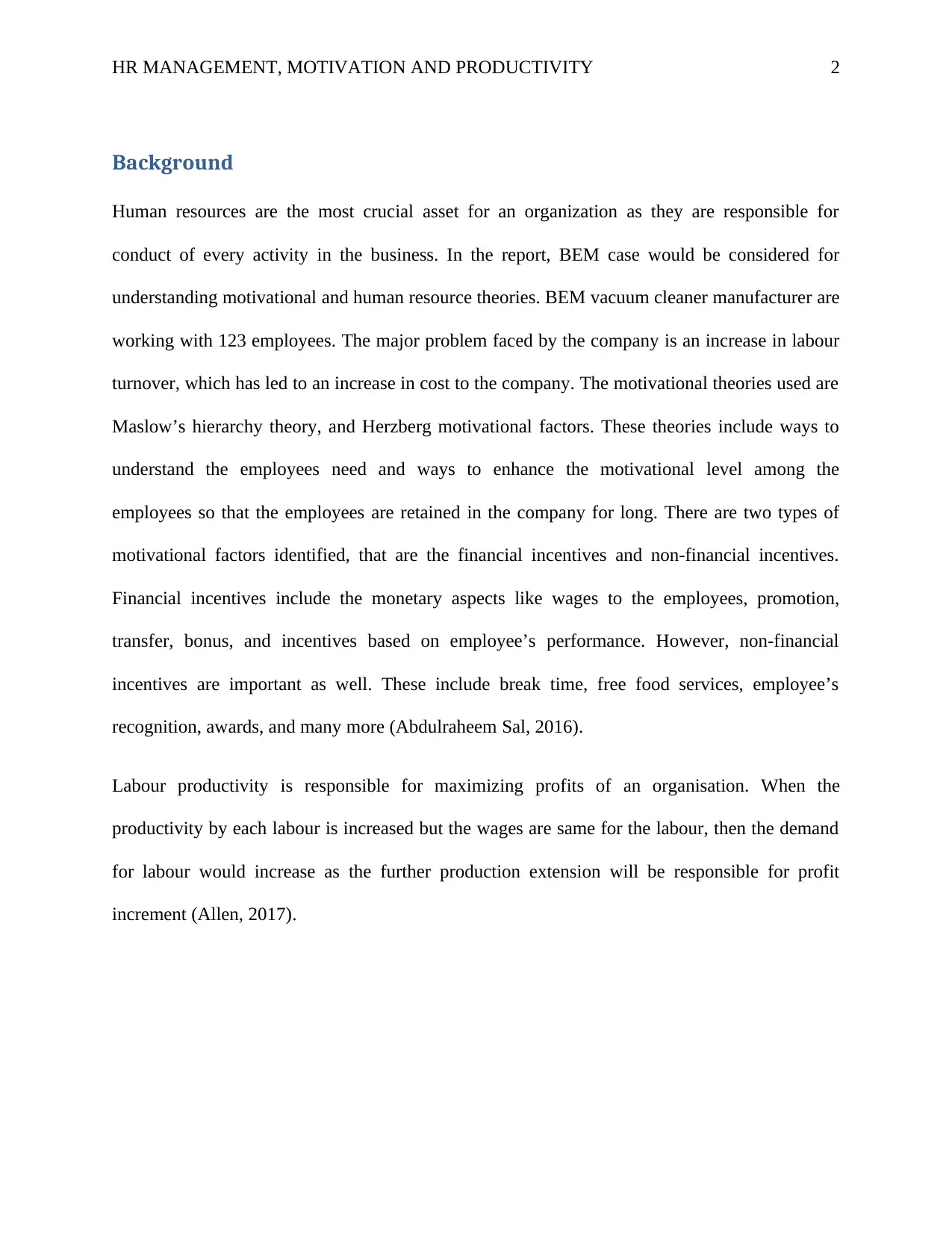
HR MANAGEMENT, MOTIVATION AND PRODUCTIVITY 2
Background
Human resources are the most crucial asset for an organization as they are responsible for
conduct of every activity in the business. In the report, BEM case would be considered for
understanding motivational and human resource theories. BEM vacuum cleaner manufacturer are
working with 123 employees. The major problem faced by the company is an increase in labour
turnover, which has led to an increase in cost to the company. The motivational theories used are
Maslow’s hierarchy theory, and Herzberg motivational factors. These theories include ways to
understand the employees need and ways to enhance the motivational level among the
employees so that the employees are retained in the company for long. There are two types of
motivational factors identified, that are the financial incentives and non-financial incentives.
Financial incentives include the monetary aspects like wages to the employees, promotion,
transfer, bonus, and incentives based on employee’s performance. However, non-financial
incentives are important as well. These include break time, free food services, employee’s
recognition, awards, and many more (Abdulraheem Sal, 2016).
Labour productivity is responsible for maximizing profits of an organisation. When the
productivity by each labour is increased but the wages are same for the labour, then the demand
for labour would increase as the further production extension will be responsible for profit
increment (Allen, 2017).
Background
Human resources are the most crucial asset for an organization as they are responsible for
conduct of every activity in the business. In the report, BEM case would be considered for
understanding motivational and human resource theories. BEM vacuum cleaner manufacturer are
working with 123 employees. The major problem faced by the company is an increase in labour
turnover, which has led to an increase in cost to the company. The motivational theories used are
Maslow’s hierarchy theory, and Herzberg motivational factors. These theories include ways to
understand the employees need and ways to enhance the motivational level among the
employees so that the employees are retained in the company for long. There are two types of
motivational factors identified, that are the financial incentives and non-financial incentives.
Financial incentives include the monetary aspects like wages to the employees, promotion,
transfer, bonus, and incentives based on employee’s performance. However, non-financial
incentives are important as well. These include break time, free food services, employee’s
recognition, awards, and many more (Abdulraheem Sal, 2016).
Labour productivity is responsible for maximizing profits of an organisation. When the
productivity by each labour is increased but the wages are same for the labour, then the demand
for labour would increase as the further production extension will be responsible for profit
increment (Allen, 2017).
⊘ This is a preview!⊘
Do you want full access?
Subscribe today to unlock all pages.

Trusted by 1+ million students worldwide
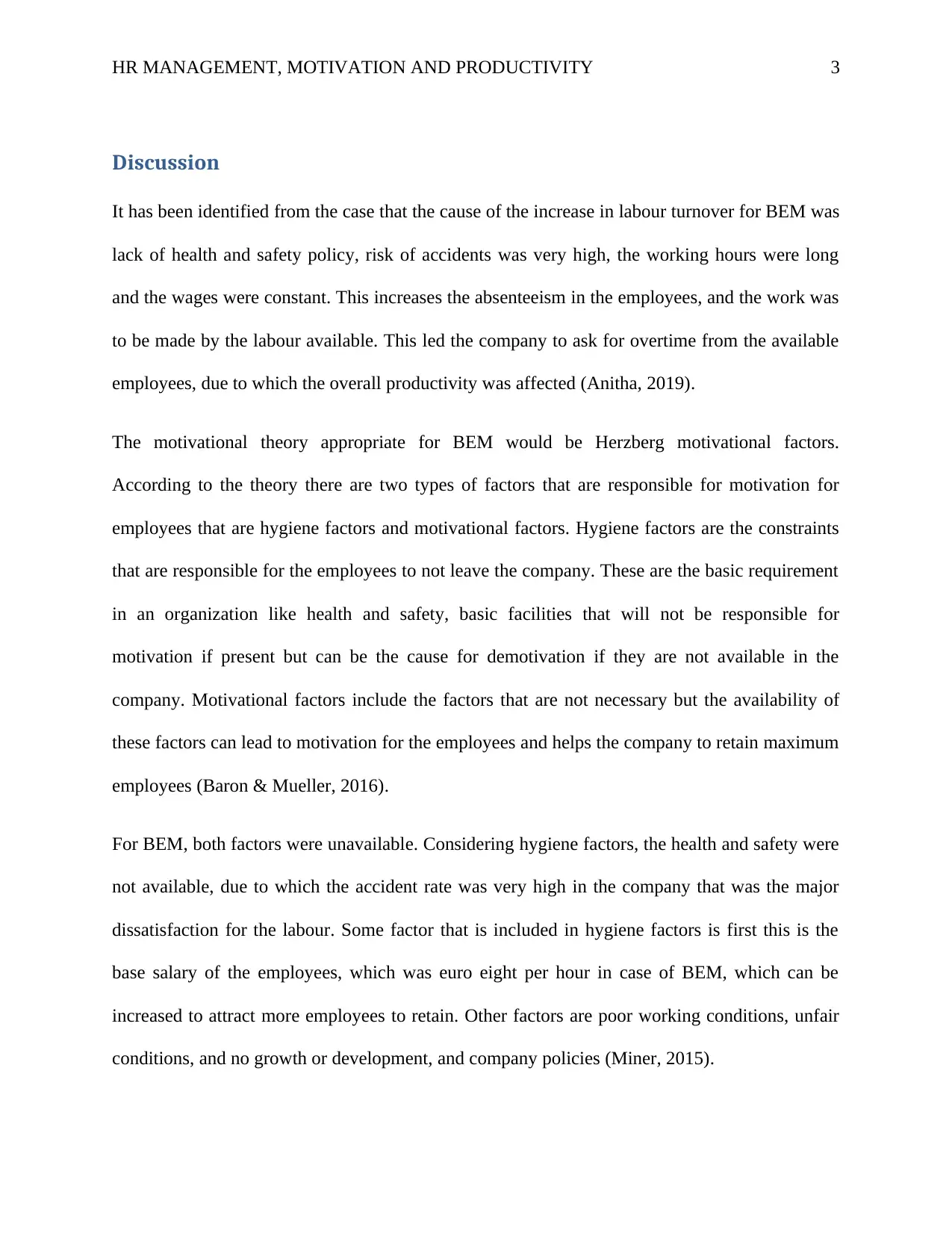
HR MANAGEMENT, MOTIVATION AND PRODUCTIVITY 3
Discussion
It has been identified from the case that the cause of the increase in labour turnover for BEM was
lack of health and safety policy, risk of accidents was very high, the working hours were long
and the wages were constant. This increases the absenteeism in the employees, and the work was
to be made by the labour available. This led the company to ask for overtime from the available
employees, due to which the overall productivity was affected (Anitha, 2019).
The motivational theory appropriate for BEM would be Herzberg motivational factors.
According to the theory there are two types of factors that are responsible for motivation for
employees that are hygiene factors and motivational factors. Hygiene factors are the constraints
that are responsible for the employees to not leave the company. These are the basic requirement
in an organization like health and safety, basic facilities that will not be responsible for
motivation if present but can be the cause for demotivation if they are not available in the
company. Motivational factors include the factors that are not necessary but the availability of
these factors can lead to motivation for the employees and helps the company to retain maximum
employees (Baron & Mueller, 2016).
For BEM, both factors were unavailable. Considering hygiene factors, the health and safety were
not available, due to which the accident rate was very high in the company that was the major
dissatisfaction for the labour. Some factor that is included in hygiene factors is first this is the
base salary of the employees, which was euro eight per hour in case of BEM, which can be
increased to attract more employees to retain. Other factors are poor working conditions, unfair
conditions, and no growth or development, and company policies (Miner, 2015).
Discussion
It has been identified from the case that the cause of the increase in labour turnover for BEM was
lack of health and safety policy, risk of accidents was very high, the working hours were long
and the wages were constant. This increases the absenteeism in the employees, and the work was
to be made by the labour available. This led the company to ask for overtime from the available
employees, due to which the overall productivity was affected (Anitha, 2019).
The motivational theory appropriate for BEM would be Herzberg motivational factors.
According to the theory there are two types of factors that are responsible for motivation for
employees that are hygiene factors and motivational factors. Hygiene factors are the constraints
that are responsible for the employees to not leave the company. These are the basic requirement
in an organization like health and safety, basic facilities that will not be responsible for
motivation if present but can be the cause for demotivation if they are not available in the
company. Motivational factors include the factors that are not necessary but the availability of
these factors can lead to motivation for the employees and helps the company to retain maximum
employees (Baron & Mueller, 2016).
For BEM, both factors were unavailable. Considering hygiene factors, the health and safety were
not available, due to which the accident rate was very high in the company that was the major
dissatisfaction for the labour. Some factor that is included in hygiene factors is first this is the
base salary of the employees, which was euro eight per hour in case of BEM, which can be
increased to attract more employees to retain. Other factors are poor working conditions, unfair
conditions, and no growth or development, and company policies (Miner, 2015).
Paraphrase This Document
Need a fresh take? Get an instant paraphrase of this document with our AI Paraphraser
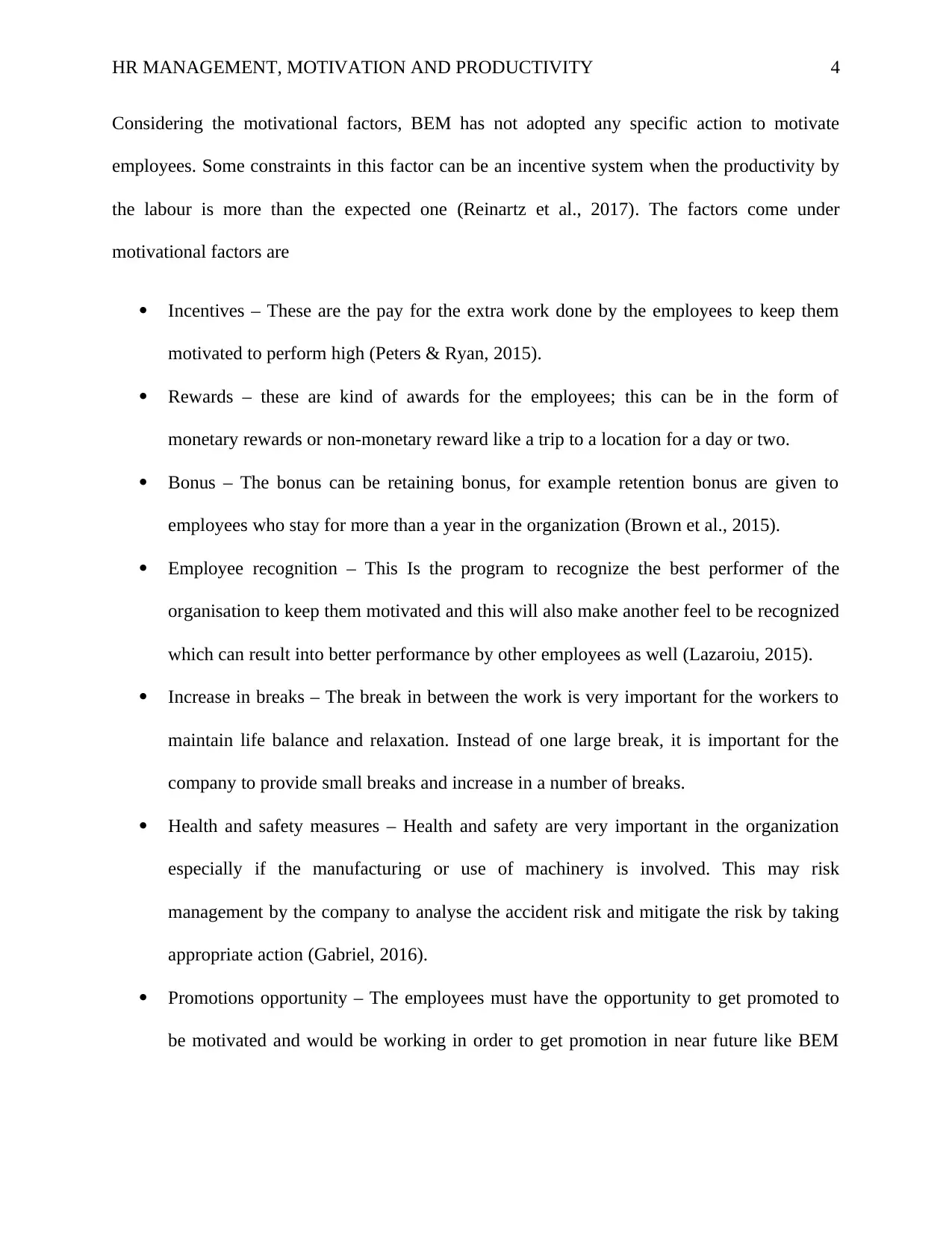
HR MANAGEMENT, MOTIVATION AND PRODUCTIVITY 4
Considering the motivational factors, BEM has not adopted any specific action to motivate
employees. Some constraints in this factor can be an incentive system when the productivity by
the labour is more than the expected one (Reinartz et al., 2017). The factors come under
motivational factors are
Incentives – These are the pay for the extra work done by the employees to keep them
motivated to perform high (Peters & Ryan, 2015).
Rewards – these are kind of awards for the employees; this can be in the form of
monetary rewards or non-monetary reward like a trip to a location for a day or two.
Bonus – The bonus can be retaining bonus, for example retention bonus are given to
employees who stay for more than a year in the organization (Brown et al., 2015).
Employee recognition – This Is the program to recognize the best performer of the
organisation to keep them motivated and this will also make another feel to be recognized
which can result into better performance by other employees as well (Lazaroiu, 2015).
Increase in breaks – The break in between the work is very important for the workers to
maintain life balance and relaxation. Instead of one large break, it is important for the
company to provide small breaks and increase in a number of breaks.
Health and safety measures – Health and safety are very important in the organization
especially if the manufacturing or use of machinery is involved. This may risk
management by the company to analyse the accident risk and mitigate the risk by taking
appropriate action (Gabriel, 2016).
Promotions opportunity – The employees must have the opportunity to get promoted to
be motivated and would be working in order to get promotion in near future like BEM
Considering the motivational factors, BEM has not adopted any specific action to motivate
employees. Some constraints in this factor can be an incentive system when the productivity by
the labour is more than the expected one (Reinartz et al., 2017). The factors come under
motivational factors are
Incentives – These are the pay for the extra work done by the employees to keep them
motivated to perform high (Peters & Ryan, 2015).
Rewards – these are kind of awards for the employees; this can be in the form of
monetary rewards or non-monetary reward like a trip to a location for a day or two.
Bonus – The bonus can be retaining bonus, for example retention bonus are given to
employees who stay for more than a year in the organization (Brown et al., 2015).
Employee recognition – This Is the program to recognize the best performer of the
organisation to keep them motivated and this will also make another feel to be recognized
which can result into better performance by other employees as well (Lazaroiu, 2015).
Increase in breaks – The break in between the work is very important for the workers to
maintain life balance and relaxation. Instead of one large break, it is important for the
company to provide small breaks and increase in a number of breaks.
Health and safety measures – Health and safety are very important in the organization
especially if the manufacturing or use of machinery is involved. This may risk
management by the company to analyse the accident risk and mitigate the risk by taking
appropriate action (Gabriel, 2016).
Promotions opportunity – The employees must have the opportunity to get promoted to
be motivated and would be working in order to get promotion in near future like BEM
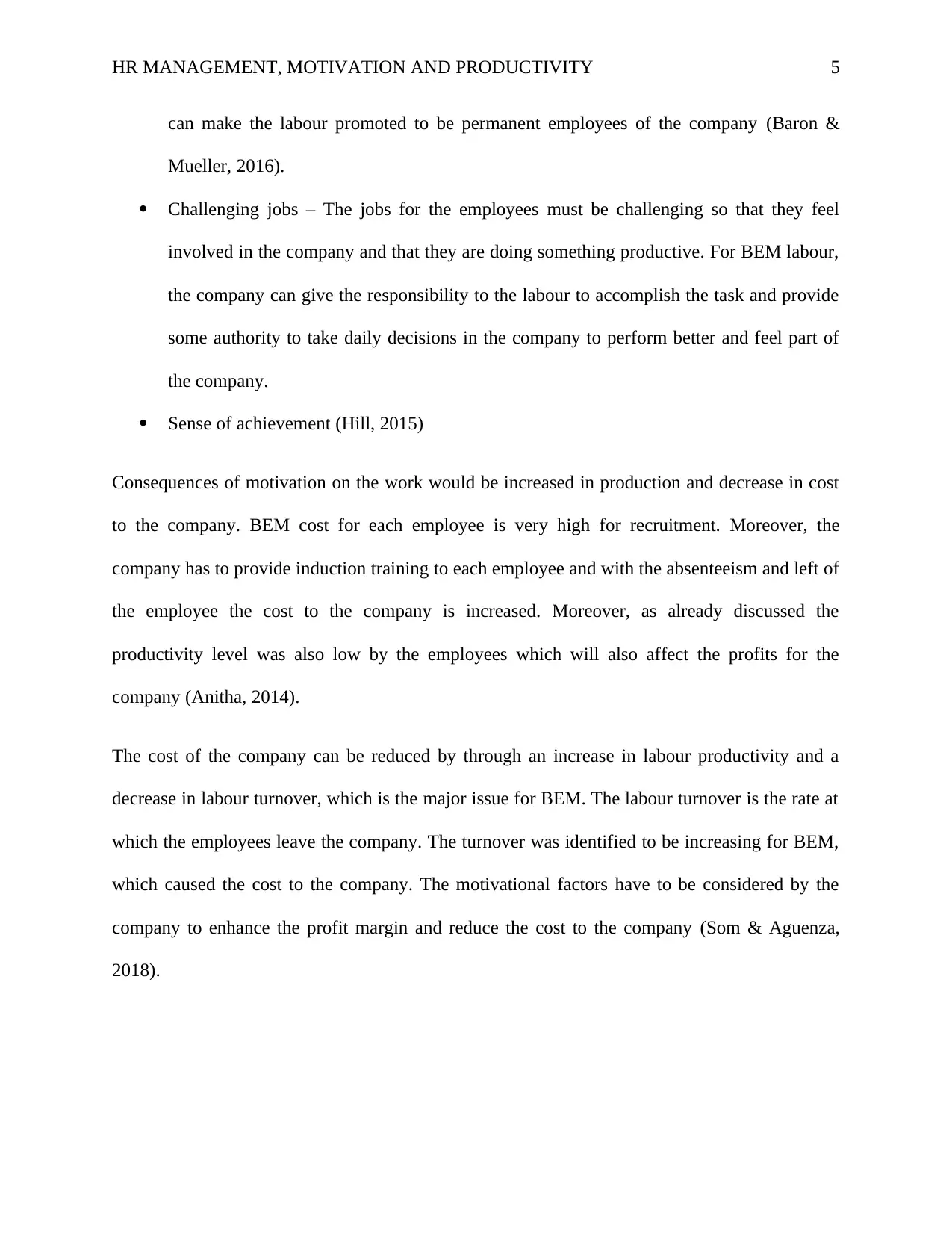
HR MANAGEMENT, MOTIVATION AND PRODUCTIVITY 5
can make the labour promoted to be permanent employees of the company (Baron &
Mueller, 2016).
Challenging jobs – The jobs for the employees must be challenging so that they feel
involved in the company and that they are doing something productive. For BEM labour,
the company can give the responsibility to the labour to accomplish the task and provide
some authority to take daily decisions in the company to perform better and feel part of
the company.
Sense of achievement (Hill, 2015)
Consequences of motivation on the work would be increased in production and decrease in cost
to the company. BEM cost for each employee is very high for recruitment. Moreover, the
company has to provide induction training to each employee and with the absenteeism and left of
the employee the cost to the company is increased. Moreover, as already discussed the
productivity level was also low by the employees which will also affect the profits for the
company (Anitha, 2014).
The cost of the company can be reduced by through an increase in labour productivity and a
decrease in labour turnover, which is the major issue for BEM. The labour turnover is the rate at
which the employees leave the company. The turnover was identified to be increasing for BEM,
which caused the cost to the company. The motivational factors have to be considered by the
company to enhance the profit margin and reduce the cost to the company (Som & Aguenza,
2018).
can make the labour promoted to be permanent employees of the company (Baron &
Mueller, 2016).
Challenging jobs – The jobs for the employees must be challenging so that they feel
involved in the company and that they are doing something productive. For BEM labour,
the company can give the responsibility to the labour to accomplish the task and provide
some authority to take daily decisions in the company to perform better and feel part of
the company.
Sense of achievement (Hill, 2015)
Consequences of motivation on the work would be increased in production and decrease in cost
to the company. BEM cost for each employee is very high for recruitment. Moreover, the
company has to provide induction training to each employee and with the absenteeism and left of
the employee the cost to the company is increased. Moreover, as already discussed the
productivity level was also low by the employees which will also affect the profits for the
company (Anitha, 2014).
The cost of the company can be reduced by through an increase in labour productivity and a
decrease in labour turnover, which is the major issue for BEM. The labour turnover is the rate at
which the employees leave the company. The turnover was identified to be increasing for BEM,
which caused the cost to the company. The motivational factors have to be considered by the
company to enhance the profit margin and reduce the cost to the company (Som & Aguenza,
2018).
⊘ This is a preview!⊘
Do you want full access?
Subscribe today to unlock all pages.

Trusted by 1+ million students worldwide
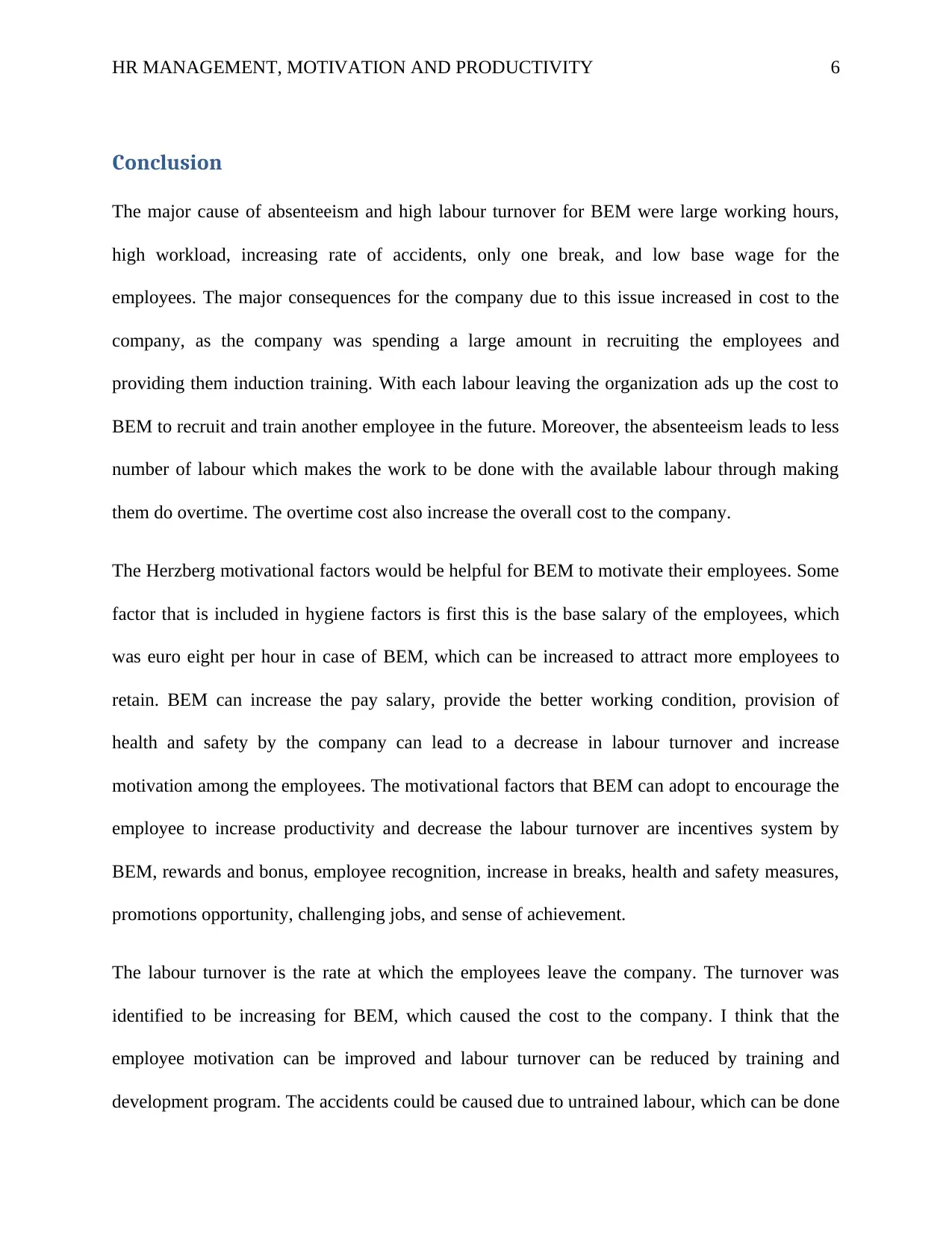
HR MANAGEMENT, MOTIVATION AND PRODUCTIVITY 6
Conclusion
The major cause of absenteeism and high labour turnover for BEM were large working hours,
high workload, increasing rate of accidents, only one break, and low base wage for the
employees. The major consequences for the company due to this issue increased in cost to the
company, as the company was spending a large amount in recruiting the employees and
providing them induction training. With each labour leaving the organization ads up the cost to
BEM to recruit and train another employee in the future. Moreover, the absenteeism leads to less
number of labour which makes the work to be done with the available labour through making
them do overtime. The overtime cost also increase the overall cost to the company.
The Herzberg motivational factors would be helpful for BEM to motivate their employees. Some
factor that is included in hygiene factors is first this is the base salary of the employees, which
was euro eight per hour in case of BEM, which can be increased to attract more employees to
retain. BEM can increase the pay salary, provide the better working condition, provision of
health and safety by the company can lead to a decrease in labour turnover and increase
motivation among the employees. The motivational factors that BEM can adopt to encourage the
employee to increase productivity and decrease the labour turnover are incentives system by
BEM, rewards and bonus, employee recognition, increase in breaks, health and safety measures,
promotions opportunity, challenging jobs, and sense of achievement.
The labour turnover is the rate at which the employees leave the company. The turnover was
identified to be increasing for BEM, which caused the cost to the company. I think that the
employee motivation can be improved and labour turnover can be reduced by training and
development program. The accidents could be caused due to untrained labour, which can be done
Conclusion
The major cause of absenteeism and high labour turnover for BEM were large working hours,
high workload, increasing rate of accidents, only one break, and low base wage for the
employees. The major consequences for the company due to this issue increased in cost to the
company, as the company was spending a large amount in recruiting the employees and
providing them induction training. With each labour leaving the organization ads up the cost to
BEM to recruit and train another employee in the future. Moreover, the absenteeism leads to less
number of labour which makes the work to be done with the available labour through making
them do overtime. The overtime cost also increase the overall cost to the company.
The Herzberg motivational factors would be helpful for BEM to motivate their employees. Some
factor that is included in hygiene factors is first this is the base salary of the employees, which
was euro eight per hour in case of BEM, which can be increased to attract more employees to
retain. BEM can increase the pay salary, provide the better working condition, provision of
health and safety by the company can lead to a decrease in labour turnover and increase
motivation among the employees. The motivational factors that BEM can adopt to encourage the
employee to increase productivity and decrease the labour turnover are incentives system by
BEM, rewards and bonus, employee recognition, increase in breaks, health and safety measures,
promotions opportunity, challenging jobs, and sense of achievement.
The labour turnover is the rate at which the employees leave the company. The turnover was
identified to be increasing for BEM, which caused the cost to the company. I think that the
employee motivation can be improved and labour turnover can be reduced by training and
development program. The accidents could be caused due to untrained labour, which can be done
Paraphrase This Document
Need a fresh take? Get an instant paraphrase of this document with our AI Paraphraser
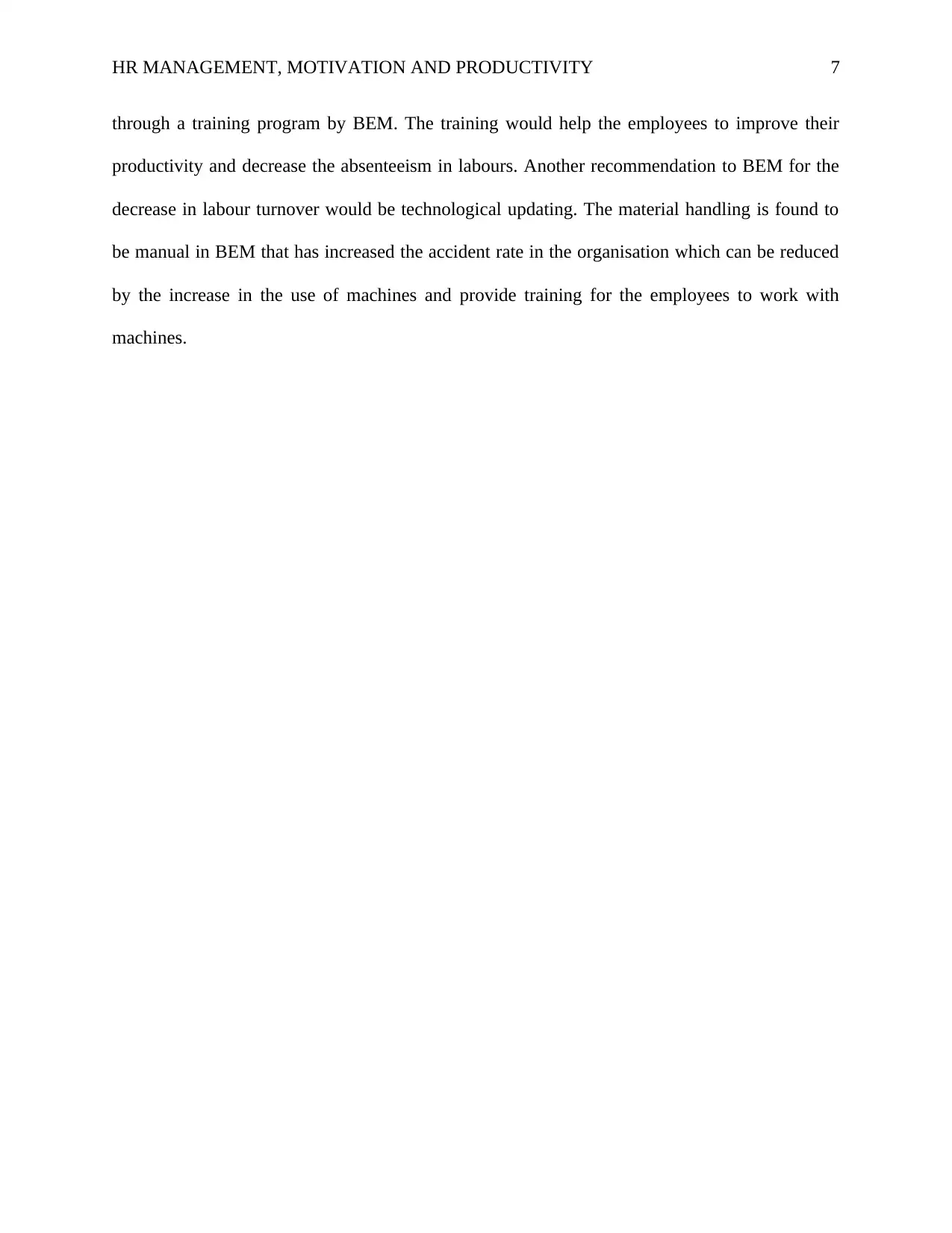
HR MANAGEMENT, MOTIVATION AND PRODUCTIVITY 7
through a training program by BEM. The training would help the employees to improve their
productivity and decrease the absenteeism in labours. Another recommendation to BEM for the
decrease in labour turnover would be technological updating. The material handling is found to
be manual in BEM that has increased the accident rate in the organisation which can be reduced
by the increase in the use of machines and provide training for the employees to work with
machines.
through a training program by BEM. The training would help the employees to improve their
productivity and decrease the absenteeism in labours. Another recommendation to BEM for the
decrease in labour turnover would be technological updating. The material handling is found to
be manual in BEM that has increased the accident rate in the organisation which can be reduced
by the increase in the use of machines and provide training for the employees to work with
machines.
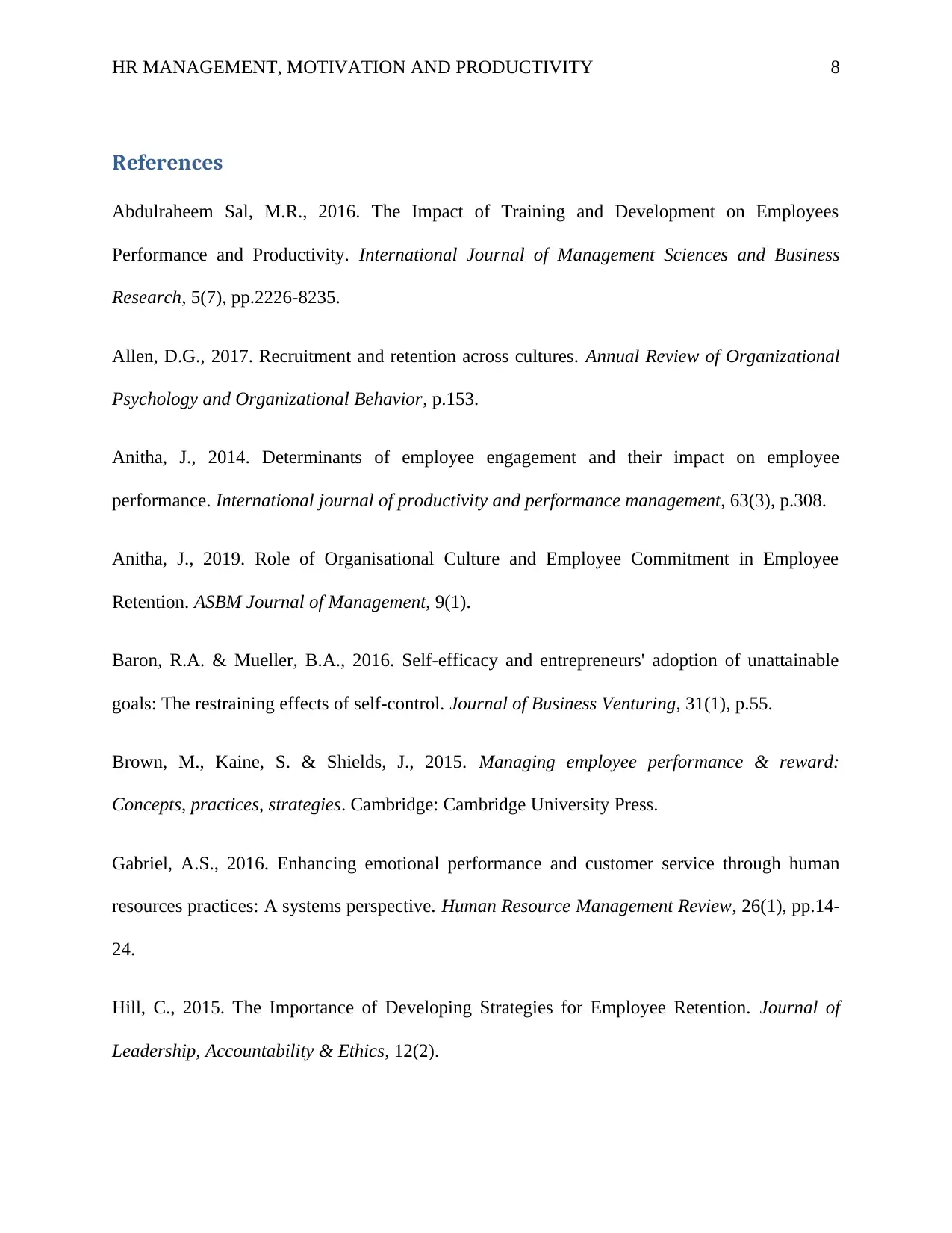
HR MANAGEMENT, MOTIVATION AND PRODUCTIVITY 8
References
Abdulraheem Sal, M.R., 2016. The Impact of Training and Development on Employees
Performance and Productivity. International Journal of Management Sciences and Business
Research, 5(7), pp.2226-8235.
Allen, D.G., 2017. Recruitment and retention across cultures. Annual Review of Organizational
Psychology and Organizational Behavior, p.153.
Anitha, J., 2014. Determinants of employee engagement and their impact on employee
performance. International journal of productivity and performance management, 63(3), p.308.
Anitha, J., 2019. Role of Organisational Culture and Employee Commitment in Employee
Retention. ASBM Journal of Management, 9(1).
Baron, R.A. & Mueller, B.A., 2016. Self-efficacy and entrepreneurs' adoption of unattainable
goals: The restraining effects of self-control. Journal of Business Venturing, 31(1), p.55.
Brown, M., Kaine, S. & Shields, J., 2015. Managing employee performance & reward:
Concepts, practices, strategies. Cambridge: Cambridge University Press.
Gabriel, A.S., 2016. Enhancing emotional performance and customer service through human
resources practices: A systems perspective. Human Resource Management Review, 26(1), pp.14-
24.
Hill, C., 2015. The Importance of Developing Strategies for Employee Retention. Journal of
Leadership, Accountability & Ethics, 12(2).
References
Abdulraheem Sal, M.R., 2016. The Impact of Training and Development on Employees
Performance and Productivity. International Journal of Management Sciences and Business
Research, 5(7), pp.2226-8235.
Allen, D.G., 2017. Recruitment and retention across cultures. Annual Review of Organizational
Psychology and Organizational Behavior, p.153.
Anitha, J., 2014. Determinants of employee engagement and their impact on employee
performance. International journal of productivity and performance management, 63(3), p.308.
Anitha, J., 2019. Role of Organisational Culture and Employee Commitment in Employee
Retention. ASBM Journal of Management, 9(1).
Baron, R.A. & Mueller, B.A., 2016. Self-efficacy and entrepreneurs' adoption of unattainable
goals: The restraining effects of self-control. Journal of Business Venturing, 31(1), p.55.
Brown, M., Kaine, S. & Shields, J., 2015. Managing employee performance & reward:
Concepts, practices, strategies. Cambridge: Cambridge University Press.
Gabriel, A.S., 2016. Enhancing emotional performance and customer service through human
resources practices: A systems perspective. Human Resource Management Review, 26(1), pp.14-
24.
Hill, C., 2015. The Importance of Developing Strategies for Employee Retention. Journal of
Leadership, Accountability & Ethics, 12(2).
⊘ This is a preview!⊘
Do you want full access?
Subscribe today to unlock all pages.

Trusted by 1+ million students worldwide
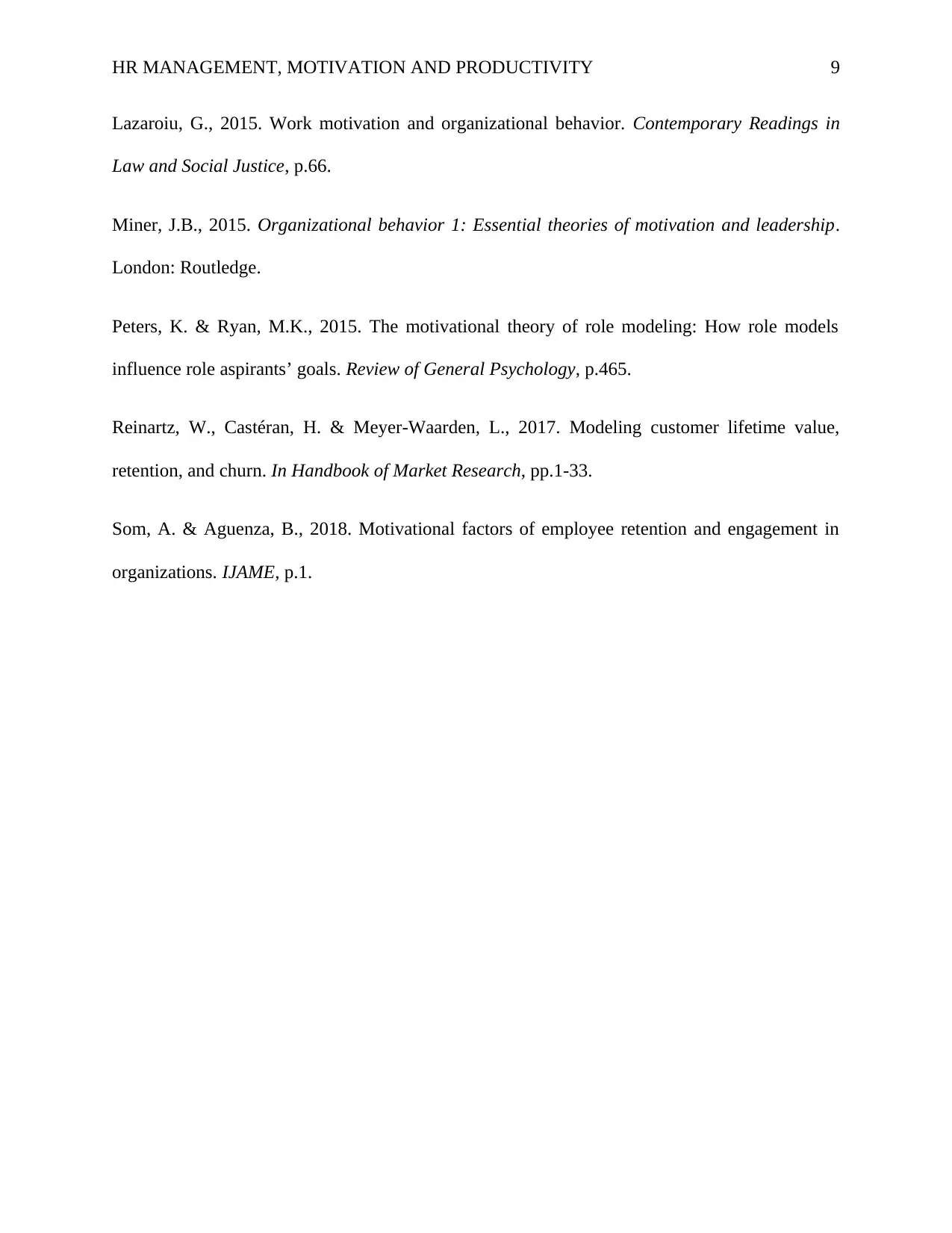
HR MANAGEMENT, MOTIVATION AND PRODUCTIVITY 9
Lazaroiu, G., 2015. Work motivation and organizational behavior. Contemporary Readings in
Law and Social Justice, p.66.
Miner, J.B., 2015. Organizational behavior 1: Essential theories of motivation and leadership.
London: Routledge.
Peters, K. & Ryan, M.K., 2015. The motivational theory of role modeling: How role models
influence role aspirants’ goals. Review of General Psychology, p.465.
Reinartz, W., Castéran, H. & Meyer-Waarden, L., 2017. Modeling customer lifetime value,
retention, and churn. In Handbook of Market Research, pp.1-33.
Som, A. & Aguenza, B., 2018. Motivational factors of employee retention and engagement in
organizations. IJAME, p.1.
Lazaroiu, G., 2015. Work motivation and organizational behavior. Contemporary Readings in
Law and Social Justice, p.66.
Miner, J.B., 2015. Organizational behavior 1: Essential theories of motivation and leadership.
London: Routledge.
Peters, K. & Ryan, M.K., 2015. The motivational theory of role modeling: How role models
influence role aspirants’ goals. Review of General Psychology, p.465.
Reinartz, W., Castéran, H. & Meyer-Waarden, L., 2017. Modeling customer lifetime value,
retention, and churn. In Handbook of Market Research, pp.1-33.
Som, A. & Aguenza, B., 2018. Motivational factors of employee retention and engagement in
organizations. IJAME, p.1.
1 out of 10
Related Documents
Your All-in-One AI-Powered Toolkit for Academic Success.
+13062052269
info@desklib.com
Available 24*7 on WhatsApp / Email
![[object Object]](/_next/static/media/star-bottom.7253800d.svg)
Unlock your academic potential
Copyright © 2020–2025 A2Z Services. All Rights Reserved. Developed and managed by ZUCOL.





